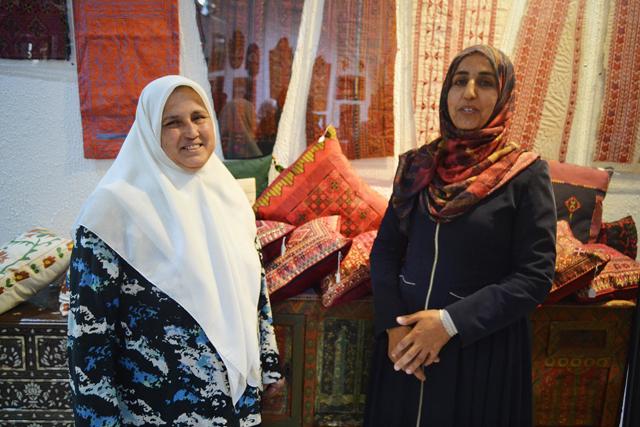You are here
Embroidery tradition of north Jordan showcased in new expo
By Ana V. Ibáñez Prieto - Oct 23,2018 - Last updated at Oct 23,2018

HRH Princess Muna inaugurates the exhibition titled ‘Alraqme’, which highlightes the Kingdom’s embroidery tradition (Photo courtesy of the Jordan Craft Centre)
AMMAN — HRH Princess Muna on Monday inaugurated an exhibition showcasing dresses, cushions, bags, shawls and abayas carrying the embroidery tradition of northern Jordan.
The exhibition, titled ‘Alraqme’ was shown at the Jordan Craft Centre (JCC) Al Aydi on Monday.
Held in cooperation with the Tiraz: Widad Kawar Home for Arab Dress, the exhibition aims to revive the heritage of the Kingdom’s embroidery tradition and preserve it from extinction, exposing antique dresses from the Widad Kawar collection as well as newly produced embroidered goods featuring modern patterns inspired by the tradition, according to a statement by the centre.
Launched under the patronage of Princess Muna, “Alraqme” is the result of the work of dozens of women based in the villages of Ajloun Governorate, who were trained to embroider using traditional Jordanian patterns by artisans at the JCC.
“Everything started in March this year, when we showed Princess Muna the antique dresses at the Widad Kawar Home for Arab Dress,” JCC Director Ahmad Hussein told The Jordan Times on Tuesday, recalling the Princess’ wish to “revive the heritage and bring it back to the Jordanian homes”.
“Soon after that meeting, I contacted artisan Iman Al Marat — who started embroidering for Al Aydi 20 years ago — and we rapidly agreed on starting to train women from her area in the old stitching techniques of northern Jordan,” Husein continued.
“The problem was that around 90 per cent of the women I work with were already used to working on cross stitches, as the unique Jordanian embroidery requires a high level of skills,” Al Marat recalled, celebrating the fact that, after the trainings, the artisans started creating new designs that “incorporated the traditional Jordanian patterns from their area, bringing together the old and the new embroidery products from northern Jordan”.
“When the Princess saw the results, she was incredibly happy to see that the idea was actually coming into action, and that is when she suggested to bring all the products together and exhibit them in one place,” Hussein noted, stressing that “this is the first time in Jordan for traditional patterns to be showcased along with modern embroidery designs”.
The project also helped create more employment opportunities for women in Ajloun Governorate, he said, pointing out that “in addition to keeping the tradition alive, these women manage to make an income by themselves while being able to work at the comfort of their own homes”.
“Nothing could make me feel more fulfilled than getting to support these women and provide them with a livelihood,” Al Marat said, referring to the 50 embroiderers she sponsors in the Ajloun area.
“We don’t have to go further than 20 years ago to find a culture of shame surrounding those village women who decided to work,” said Hussain, explaining that “women like Iman have made people in these communities more used to seeing a woman working, travelling by herself to the city to get the materials and becoming independent — they are strong and empowered".
Related Articles
AMMAN — Deputising for HRH Princess Muna, HRH Princess Sana Asem on Tuesday inaugurated an exhibition featuring embroidery from Jordan’s sou
AMMAN — When Iman Imarat started embroidering for the Jordan Craft Centre (JCC) Al Aydi at the age of 22, she knew little about how much her
Deputising for HRH Princess Muna, HRH Princess Wijdan Al Hashemi inaugurated an exhibition showcasing a collection of traditional dresses and jewellery items from Bethlehem and its surrounding villages, the Jordan News Agency, Petra, reported.

















